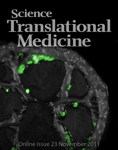来自波士顿戴纳-法柏癌症研究所的一组研究人员通过实验发现,杀菌/渗透性增加蛋白(BPI)与抗生素联用可以显着延长受放射性损伤小鼠的生存期,甚至在接受暴露24小时后用药仍有效,其研究结果近日发表在《科学转化医学》杂志上。

大多数现有用于治疗放射性损伤的药物,包括碘化钾和蛋白质粒细胞集落刺激因子都必须在暴露之前或暴露后数小时内使用才有效,而这在实际情况中如核泄漏事故中是很难做到的。
一开始研究人员发现,接受骨髓移植的患者,若再使用放射治疗,其肠壁细胞的更新速度会减慢,发生细菌感染的机会便增加,而这些感染的患者血液中的BPI水平会降低。
由于伦理学的原因,研究人员使用小鼠作为受试对象。研究者使受试小鼠暴露于剂量为7戈的辐射,30天后,95%的小鼠都已死亡;随后,他们使用另外一组小鼠重复实验,发现其血液中BPI水平没有显着变化;当研究者使用喹诺酮类抗生素对第三组小鼠进行治疗后,发现40%的小鼠生存期超过了30天;第四组小鼠的治疗联合使用BPI与喹诺酮类抗生素,30天生存率达到了75%。
德州农工大学卡城分校创新疗法学院主任Brett Giroir称,人类对BPI的抗内毒素作用更为敏感,因此其在人类身上的作用可能会更加显着。

Bactericidal/Permeability-Increasing Protein (rBPI21) and Fluoroquinolone Mitigate Radiation-Induced Bone Marrow Aplasia and Death
Eva C. Guinan, Christine . Barbon, Leslie A. Kalish, Kalindi Parmar, Jeff Kutok, Christy J. Mancuso, Liat Stoler-Barak, Eugénie E. Suter, Janice D. Russell1, Christine D. Palmer, Leighanne C. Gallington, Annie Voskertchian, Jo-Anne Vergilio, Geoffrey Cole, Kaya Zhu, Alan D’Andrea, Robert Soiffer, Jerrold P. Weiss and Ofer Levy
Identification of safe, effective treatments to mitigate toxicity after extensive radiation exposure has proven challenging. Only a limited number of candidate approaches have emerged, and the U.S. Food and Drug Administration has yet to approve any agent for a mass-casualty radiation disaster. Because patients undergoing hematopoietic stem cell transplantation undergo radiation treatment that produces toxicities similar to radiation-disaster exposure, we studied patients early after such treatment to identify new approaches to this problem. Patients rapidly developed endotoxemia and reduced plasma bactericidal/permeability-increasing protein (BPI), a potent endotoxin-neutralizing protein, in association with neutropenia. We hypothesized that a treatment supplying similar endotoxin-neutralizing activity might replace the BPI deficit and mitigate radiation toxicity and tested this idea in mice. A single 7-Gy radiation dose, which killed 95% of the mice by 30 days, was followed 24 hours later by twice-daily, subcutaneous injections of the recombinant BPI fragment rBPI21 or vehicle alone for 14 or 30 days, with or without an oral fluoroquinolone antibiotic with broad-spectrum antibacterial activity, including that against endotoxin-bearing Gram-negative bacteria. Compared to either fluoroquinolone alone or vehicle plus fluoroquinolone, the combined rBPI21 plus fluoroquinolone treatment improved survival, accelerated hematopoietic recovery, and promoted expansion of stem and progenitor cells. The observed efficacy of rBPI21 plus fluoroquinolone initiated 24 hours after lethal irradiation, combined with their established favorable bioactivity and safety profiles in critically ill humans, suggests the potential clinical use of this radiation mitigation strategy and supports its further evaluation.








